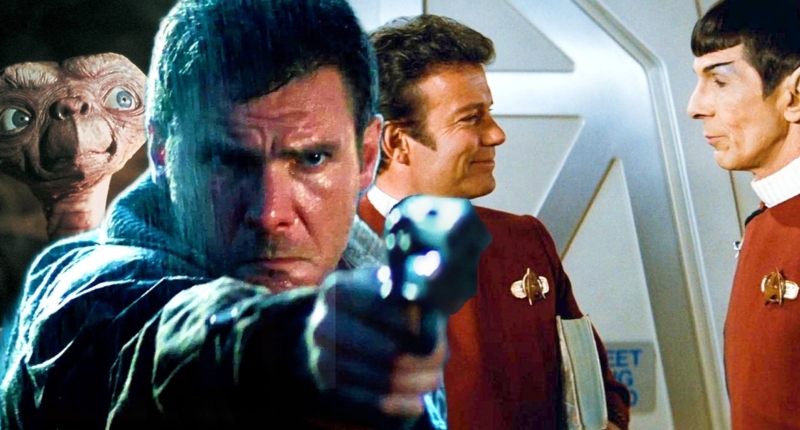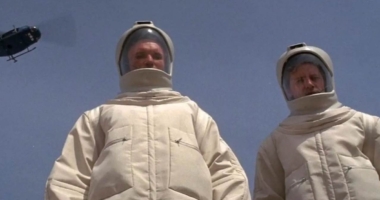1982 was a pivotal year in science fiction movies, with the release of five movies that revolutionized the genre. Blade Runner codified the cyberpunk aesthetic, while The Thing is now considered a cult classic. Star Trek II: The Wrath of Khan reshaped the iconic franchise, while Tron pioneered the use of computer-generated imagery. E.T. the Extra-Terrestrial was the most successful science fiction movie of 1982 and spent 17 non-consecutive weeks at the top of the box office. The image of the flying bikes crossing the night sky is one of the most unforgettable in cinematic history. The American Film Institute named it the 24th greatest film ever in its 2007 poll. These five movies changed the genre forever, with each one of them revolutionizing a particular aspect of science fiction filmmaking. They are a testament to the power of innovation and creativity in the film industry, and their influence can still be felt in contemporary science fiction films.
The Year That Revolutionized Science Fiction Movies
The science fiction genre has been an integral part of cinema history, ever since Georges Méliès’ A Trip to the Moon premiered. Nevertheless, there was one particular year that changed the way audiences perceived it, especially in terms of American blockbuster movies. This is not to say that science fiction films released prior to that year became irrelevant, but rather that this specific year left an indelible mark on the genre.
1982 marked the beginning of a new era for science fiction movies. Following the success of Star Wars in 1977, every major film studio raced to produce science fiction films to capitalize on its popularity. This led to a period in the late 1970s and early 1980s when science fiction became one of the most popular genres in film.
Five major science fiction movies were released in 1982 that went on to change the genre forever. The first of these, Star Trek II: The Wrath of Khan, premiered on June 4th. Although it was the second movie adaptation of Gene Roddenberry’s famous science fiction TV show, it is often considered the most exceptional film in the series. A week later, on June 11th, Steven Spielberg’s E.T. the Extra-Terrestrial hit theaters, becoming the highest-grossing film of all time, surpassing the box office success of Star Wars. It held the title until 1993.
Contrary to the overwhelming commercial success of E.T. the Extra-Terrestrial, the two science fiction films released on June 25th were initially box office failures. However, both movies gained cult followings in the following years. John Carpenter’s The Thing and Ridley Scott’s Blade Runner were praised for their dark, dystopian themes and remarkable cinematography. Scott’s Blade Runner: The Final Cut, which included additional footage, was especially well-received after its release due to the negative impact of studio interference on the original theatrical cut.
The fifth and final movie that defined the science fiction genre in 1982 was Tron, which premiered on July 9th. It was notable for its groundbreaking use of computer-generated imagery for sequences inside the ENCOM mainframe.
In conclusion, 1982 was the year that revolutionized science fiction movies, introducing new themes, cinematography techniques, and visual effects. These five films continue to be relevant today, as their influence can still be seen in contemporary science fiction films.
How 1982 Changed Science Fiction Movies Forever
Science fiction movies have been captivating audiences since the inception of cinema, but 1982 marked a turning point in the genre. The release of five movies that year fundamentally changed the way audiences viewed science fiction films. Here is how each of these movies revolutionized the genre.
Blade Runner: Revolutionizing Cyberpunk Aesthetic
Blade Runner was an iconic movie that redefined the cyberpunk aesthetic. It was the perfect balance between neon and noir, and the impeccable production design was matched by the film’s ingenious special effects. The movie used “multipass exposures” for increased fidelity in its model shots compared to standard optical effects.
The Thing: A Cult Classic in Science Fiction/Horror
Despite being critically panned upon its release, The Thing is now considered a high point in science fiction/horror filmmaking. Rob Bottin’s special effects work on the film is widely regarded as among the greatest in film history, which is especially impressive given that he was only 21 at the time.
Star Trek II: The Wrath of Khan: Reshaping the Iconic Franchise
Star Trek II: The Wrath of Khan revolutionized one of science fiction’s most important franchises. The sequel’s director, Nicolas Meyer, redesigned the iconic multicolored costumes into naval-inspired red costumes, a decision that stayed with the franchise for its sequels. The film’s action-packed plot propelled the cult franchise into the mainstream.
Tron: Pioneering Use of Computer-Generated Imagery
Tron was a pioneer in visual effects, with approximately 20 minutes worth of computer-generated imagery. Sequences that utilized early CGI include the iconic “lightbike” scene. Due to technical limitations at the time, all the CGI frames were generated one by one and then physically photographed.
E.T. the Extra-Terrestrial: The Most Successful Science Fiction Movie of 1982
E.T. the Extra-Terrestrial spent 17 non-consecutive weeks at the top of the box office and was the most successful science fiction movie of 1982. The film’s iconic image of the flying bikes crossing the night sky, backlit by the moon, is one of the most unforgettable in cinematic history. The American Film Institute (AFI) named it the 24th greatest film ever in its 2007 poll.
In conclusion, 1982 was a significant year in science fiction cinema. These five movies changed the genre forever in different ways, with each one of them revolutionizing a particular aspect of science fiction filmmaking. They are a testament to the power of innovation and creativity in the film industry, and their influence can still be felt in contemporary science fiction films.
Don’t miss interesting posts on Famousbio









